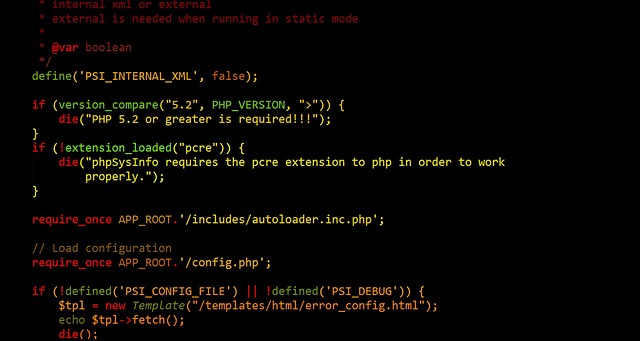What are enterprise applications? How do they function and why are they crucial in today’s technologically driven business environment? Just as impactful, what other terms can be used to describe these vital business tools?
The issue at hand, defined by scholarly sources such as the International Journal of Business Information Systems and the Journal of Enterprise Information Management, is the frequent misinterpretation and lack of understanding surrounding enterprise applications. With technology consistently evolving, it is increasingly essential for businesses to stay up to speed with related terminology and functions. As such, the common misunderstanding of what enterprise applications are, and their various aliases, is not just confusing but can potentially inhibit business processes. A proposal to clear the confusion involves detailed exploration and clearer exposition of the subject matter.
In the forthcoming article, you’ll unearth a wealth of knowledge relating to enterprise applications, their diverse monikers, and their practical significance. The numerous names attributed to enterprise applications, the rationale behind their creation and usage and critical considerations about their implementation and management will be unveiled.
From this piece, you’ll gain a detailed understanding of the terminology associated with enterprise applications. The article aims to eradicate any misunderstandings, providing clear, concise, and valuable information beneficial to anyone involved in the business and technology sectors. Knowledge empowerment is the purpose, as we delve into the fascinating world of enterprise applications.

Definitions of Enterprise Applications
Enterprise applications, also known as business applications, are sophisticated computer software designed to integrate all aspects of a company’s operations and processes.
Enterprise applications are comprehensive systems that facilitate the flow of information across all business roles and offer a specific set of business tasks. These include functions such as billing systems, customer relationship management, and supply chain management.
Business applications on the other hand, is a term often used interchangeably with enterprise applications. It refers to the software the company employs to perform various business functions. It can include a variety of programs, from spreadsheet programs to complex, industry-specific proprietary software.
Challenging the Myths: Enterprise Applications and their Unexpected Impact
Unveiling the Myths Surrounding Enterprise Software
Enterprise Applications, also known as Enterprise Software, are large-scale software systems designed to integrate and streamline various business processes within an organization. They have a profound impact on businesses, often changing the entire landscape of operations and strategies. However, there are several myths associated with these robust software systems that often lead to misconceptions. One of these misconceptions is that Enterprise Software is difficult to implement and customize. However, modern enterprise applications are user-friendly and flexible, designed to seamlessly integrate with the existing software ecosystem of a business, thereby debunking this myth.
Business enterprise applications
Microsoft 365 Apps for Enterprise
Enterprise Business apps generator
Another popular myth associated with enterprise applications is that they are too expensive. While it’s true that enterprise applications can be costly, they’re also an essential investment for businesses seeking efficiency and scalability. When seen in terms of long-term gains—improved productivity, streamlined processes, and better business intelligence—it’s clear that enterprise software offers significant return on investment.
The Unexpected Impact of Enterprise Applications
Businesses often underestimate the potential benefits of adopting enterprise software. They’re seen as simple tools to optimize specific areas of operation, like procurement or supply chain management. However, their impact extends far beyond these basic assumptions.
- Improved Decision-Making: With their ability to gather and analyze data, enterprise software offers businesses significant insights. This helps in making informed and timely business decisions, thereby improving overall efficiency.
- Improved Collaboration and Communication: By breaking down silos and promoting seamless collaboration across teams, enterprise software fosters a culture of efficient communication. This in turn leads to better workflow and productivity.
- Increased Customer Satisfaction: Enterprise software can naturally boost customer satisfaction. By streamlining the customer journey and offering personalized experiences, businesses can earn customer loyalty and improved brand image.
Despite the misconceptions and myths, the adoption of enterprise software has proven beneficial for businesses of all sizes. They have more to offer than just simple automation; they have the power to transform the complete business scenario, enhancing agility, efficiency, and competitive advantage. By clearly understanding the impact and potential of enterprise software, businesses can leverage them in the best possible way to ascend the ladder of success.
Breaking Barriers: Understanding the Revolutionary Potential of Enterprise Applications
Unleashing the Hidden Power
Have you ever stopped to wonder about the unexplored potential of business software systems? These tools, often referred to as enterprise applications, are revolutionizing how we conduct business operations. They are helping to break many barriers that have traditionally been limiting growth and efficiency. One such barrier is the siloed nature of traditional business processes and departments. This lack of cohesion and visibility across various business operations often leads to inefficiencies and redundancies, hampering the speed and effectiveness of decision-making processes. However, with the help of enterprise applications, businesses can now integrate their operations and workflows seamlessly. These applications offer a unified platform that provides visibility into all business processes, thereby facilitating data-driven decision-making.
Addressing the Underlying Challenges
A significant challenge that many businesses face while integrating enterprise applications is their complexity and the potential disruptions they may cause to existing workflows. Implementing these systems often requires a complete overhaul of existing infrastructures and processes, which can be a daunting task for many organizations. Additionally, the integration often involves dealing with massive amounts of data, raising concerns over data management and security. Another critical hurdle lies in change management as these enterprise applications usually necessitate a shift in the business’ operational approach and employee roles. Hence, the failure to properly manage this change can lead to resistance and possible project failure.
Evidence of Best Practices
Numerous successful examples exist where organizations have effectively capitalized on enterprise applications to revolutionize their business processes. For instance, a prominent technological solutions provider, using an integrated enterprise application suite, was able to streamline its operations and improve its response time to customer requests. By integrating their sales, inventory, and customer management modules, they significantly improved their resource utilization and operational efficiency. Likewise, a reputed healthcare chain implemented a comprehensive enterprise application to integrate its various departments, such as patient management, diagnostics, and billing. This led to improved patient care, as the physicians had instant access to all requisite information. These examples clearly indicate that despite the challenges, the successful integration of enterprise applications can prove instrumental in breaking operational barriers and achieving unprecedented levels of efficiency and growth.
Unmasking the Giants: The Invisible Power of Enterprise Applications in Today’s Businesses
Unseen Powerhouse: The Mystique of Corporate Software
Do we ever stop to really consider the true prowess of enterprise applications? Often operating silently in the background, they provide essential support to every aspect of the day-to-day operations in many of today’s businesses. Although they might not immediately spring to mind when we think of key players in the industrial world, their influence is undeniable.
Enterprise applications, or corporate software as they are also known, are large scale software systems designed to integrate and satisfy the needs of an entire organization rather than individual users. This can cover a whole spectrum of functions, from human resources to supply chain management, each one custom-built and tailored to tackle the specific needs and challenges of a particular enterprise. This invisible might facilitates seamless processes and workflows which, in turn, add substantial value to the companies that implement them properly.
Encountering the Elephant in the Room
The main challenge lies in realizing the full potential of these colossal software systems. In the absence of proper understanding and efficient implementation strategies, these applications can become more hindrance than help. Therefore, necessary effort must be invested in ensuring the system is thoroughly integrated within the company’s established processes, as well as being consistently updated and improved upon.
In many instances, companies experience considerable difficulties due to the innate complexity of enterprise applications. The broad range of functionalities these systems possess can be difficult to navigate and understand. Furthermore, the intricate task of successfully integrating these applications into the pre-existing company’s infrastructure can pose significant challenges. This, combined with the continual need for updating and troubleshooting, can lead to an array of problems if not properly managed.
Illuminating The Path to Success
Fortunately, there are numerous successful examples illustrating how companies have overcome these challenges and reaped the benefits. One such is the multinational retail corporation, Walmart. They have meticulously integrated an advanced enterprise application throughout their operations, resulting in significant improvements in logistics and supply chain management. This clever use of enterprise software boosted efficiency substantially, ultimately strengthening their market position.
In a similar vein, coffees giant Starbucks worked closely with their enterprise software providers to create a bespoke cloud-based application. This system helps manage inventories, supplier relationships, and even customer preferences at each individual store. The outcome is a streamlined operational process, less wastage, and a tailored customer experience. These are just a few examples highlighting the transformative nature of well-implemented enterprise applications.
Conclusion
Have you ever contemplated on the increasing importance of business software in our society today? The functionality and coordination they bring to companies cannot be overemphasized. They streamline tasks, optimize workflows, and impacts overall business efficiency, contributing immensely to the viability and profitability of businesses. As such, enterprise applications, also known commonly as business applications, are veritable tools that are integral to the operations and management of businesses, regardless of their size. Their propensity to bridge the gap between complex business processes and improve productivity makes them an invaluable resource in the marketplace today.
As ardent lovers of tech and business strategy, we encourage you to stay connected with us for cutting-edge insights into the world of business software. With the rapidly evolving tech space, there’s always something new to discover, learn and adapt to improve your business operations. We are dedicated to keeping you updated with the most recent trends, topics, and relevant content. Our commitment is powering your knowledge of how business software is transforming the way we work, making companies more efficient, and driving business success.
We know you are eagerly looking forward to our future releases. We promise they are worth the wait and more! With every new release, we delve deeper into the intricate world of enterprise applications, exploring their features, impacts, and how they shape businesses’ operational landscape. In essence, you not only become more technologically savvy but also become better equipped to optimize these applications’ use for improved business operations and management. Thank you for being a part of our community, and remember, there’s always something exciting around the corner!
F.A.Q.
Sure, here’s your FAQ section:
1. What are Enterprise Applications?
Enterprise applications, also known as enterprise software, are centralized systems that help businesses solve enterprise-wide issues. They help in automating and optimizing business processes, thus enhancing the overall efficiency of the organization.
2. What is the purpose of Enterprise Applications?
The main purpose of these applications is to improve the productivity and efficiency of a business. They simplify various complex processes within a business by eliminating any possible redundancies.
3. What are some examples of Enterprise Applications?
Examples of enterprise applications include Customer Relationship Management (CRM) systems, Enterprise Resource Planning (ERP) systems, and Supply Chain Management (SCM) software. These tools are typically used to manage a business’s daily operations more effectively and efficiently.
4. Can small businesses benefit from Enterprise Applications?
Yes, small businesses can significantly benefit from enterprise applications. They can use these applications to streamline their operations, reduce manual work, and increase their operational efficiency.
5. How are Enterprise Applications implemented in a business?
Implementing enterprise applications usually involves thorough planning, customization, and testing. A business may need to hire IT professionals to ensure the applications are implemented correctly and provide the desired efficiencies.



